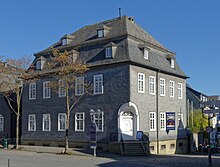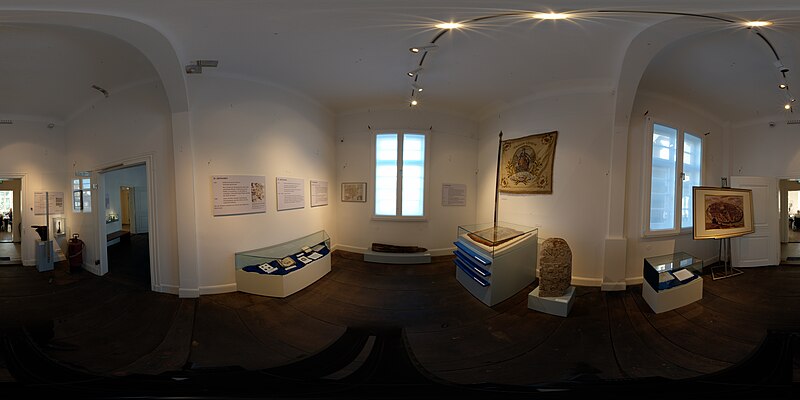Museum Haus Hövener
The Museum Haus Hövener is a local history museum in Brilon .
The museum is located in the listed historic Hövener house . During her lifetime Wilhelmine Hövener founded the Briloner Eisenberg and Trades Foundation - Brilon City Museum .
history
The museum was founded in 1983 and was initially located in the guest house . The museum was later housed in the Henning house on Heinrich-Jansen-Weg. After the renovation of the Hövener house, the city museum has been relocated there under its new name, Museum Haus Hövener, on the market square, and the existing exhibits have been integrated where appropriate.
The owner and founder family was involved in the metallurgy and mining industry for over four centuries and left behind extensive furniture, a specialist library, an ancestral gallery, an economic archive and many objects from upper-class life. Thus, the history of a former mining region can be comprehensively presented. Wilhelmine Hövener lived in after the death of her mother Antonia Hövener, b. Weeds, the great building alone. Apart from a small room with functional furniture and literature, she added very little to the household. She used the items of the previous generations and received almost all household items. Households of the bourgeoisie thus preserved are almost never preserved. Apart from a household split on the occasion of a wedding in 1930, when a number of objects were brought to Münster, the household has not been split since the middle of the 19th century. The collection was taken over as a donation from the Westphalian Open Air Museum in Detmold, as instructed by the founder . Selected pieces form the basis of the Museum Haus Hövener on permanent loan.
Structure of the exhibition
The house has a total of 24 rooms spread over 1,150 m². The exterior and interior architecture are also part of the exhibition.
Basement
Earth history and dinosaurs in Brilon-Nehden
The walls were provided with background images by the painter Katrin Keller, so that the impression of a landscape is created as it could have looked 120 million years ago at the time of the dinosaurs. In 1978, bones of the Iguanodon were found in the excavation site of the dinosaurs in a quarry in Nehden . A complete skeleton, which has been provided with a dermoplastic skin for demonstration purposes, and fragments of 15 other specimens are shown. Large bones hang on the walls. The stair handrail from the basement to the ground floor is painted in different colors, symbolizing the different geological periods.
ground floor
The entrance area with oak beams is decorated with an exposed wreath of oak leaves . This is where the foyer and checkout area are located . An old ceiling painting was exposed during the renovation work. Parts of the wooden staircase leading to the top date from 1803, when the house was built.
Exhibition rooms for special exhibitions
Exhibitions on various topics are shown on irregular dates.
Interactive city model
Several hundred years of Brilon's city history are documented here. In this scope it is unique in Germany and represents one of the most important exhibits.
The former inner city is reproduced on a scale of 1: 600. About 500 historic buildings are shown on a map dating from around 1900. The buildings are selected using a touchscreen and illuminated using a projector. Information about the building that is stored in a database opens. Old photographs, drawings and other views are also digitized.
City history
You can see a city seal of the city of Brilon, a historical Schnadestein from 1769 and a Schnade flag from this time. A fragment of the old wooden water pipe documents the early modern water supply.
Remise
Special exhibitions
Exhibitions with paintings or porcelain are planned here.
First floor
Mining and metallurgy
A unique concept of economic and cultural history is presented here. In the past, the Sauerland was a flourishing industrial and commercial region. The existing exhibits are also used to build bridges to the deserts and monuments in the area .
In the digitized specialist library for mining, the holdings can be viewed at a standing desk.
Cold spar mining and lead smelting, furnace art casting and utility foundry are impressively staged. An original Brilon stove is also on display.
Family history
A pedigree of the Weeds family as well as paintings and graphics with portraits of family members from the past centuries are hung in this section. Pictures by Everhard Jodokus Kannegießer , Cornelius Dammers and Johann Heinrich Weed will be presented. Furniture, accessories and original parts are part of the exhibition. An old circular oven from 1870 and bathroom and kitchen furniture from around 1910 complete the exhibition.
Family history comes to life in an interactive concept. In the ancestral gallery you can see the digitized correspondence between Charlotte Catharina Unkraut, her son Richard, her daughter-in-law Regine nee. Have Kropff and daughter Catharina Peters read aloud. An authentic picture of family life in Biedermeier is presented.
Attic
Brilon bell foundry
A wooden model with letters for the bell casting is attached to a shelf on the wall. Two bells are on display.
Historical forest use
The topic of forest and charcoal production is impressively staged, a special exhibit is the shawm made from twisted dry tree bark.
Special exhibitions
Exhibitions on various topics are shown on irregular dates.
Upper attic
Here you can see the roof beams, which have only been superficially cleaned and not restored, as well as the raw boards of the floor. At the top of the attic, a narrow staircase further up, a photo documents the found situation of the exhibits in the attic. An old wooden winch has been preserved.
literature
- Stefan Baumeier, Katharina Schlimmgen-Ehmke (ed.): Golden times. Sauerland economic citizens from the 17th to the 19th century . Klartext, Essen 2011, ISBN 3-89861-006-3 .
Web links
Individual evidence
- ^ Förderverein Haus Hövener - Stadtmuseum Brilon e. V. (fvhh) ( Memento of the original dated February 3, 2009 in the Internet Archive ) Info: The archive link was inserted automatically and has not yet been checked. Please check the original and archive link according to the instructions and then remove this notice.
- ↑ Gerd Dethlefs: Bourgeois ancestors. A sign of tradition and aspiration . In: Stefan Baumeier, Katharina Schlimmgen-Ehmke (ed.): Golden times. Sauerland economic citizens from the 17th to the 19th century . Klartext, Essen 2011, pp. 228–243.
- ↑ Stefan Baumeier: "4 Sophas and 4 chests of drawers". Notes on bourgeois furniture in the eastern Sauerland . In: Stefan Baumeier, Katharina Schlimmgen-Ehmke (ed.): Golden times. Sauerland economic citizens from the 17th to the 19th century . Klartext, Essen 2011, pp. 198–215.
Coordinates: 51 ° 23 ′ 44 ″ N , 8 ° 34 ′ 6 ″ E















